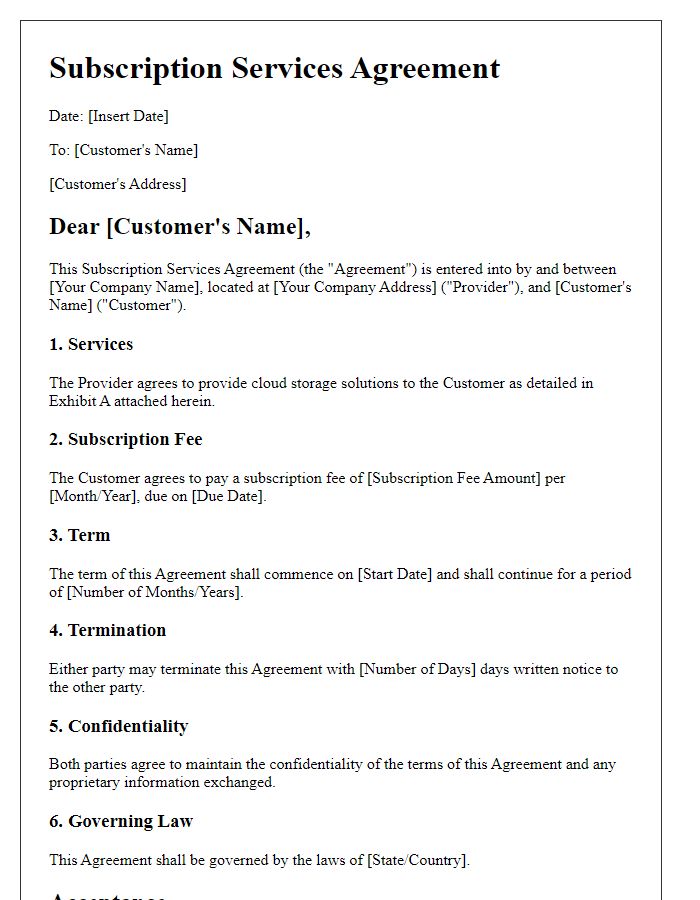Are you considering entering into a subscription services agreement but not sure where to start? Writing the perfect letter can set the tone for a successful partnership, ensuring all your terms and expectations are clear from the get-go. In this article, we'll explore essential components of a subscription letter, including key clauses and tips for effective communication. So, let's dive in and discover how to craft a compelling subscription services agreement that works for you!

Clear Service Description
Subscription services agreements require a clear service description to ensure users understand what they are enrolling in. Each service typically includes aspects such as the type of content provided, frequency of updates, duration of subscription (monthly, annually), and any limitations on access (device restrictions, geographical boundaries). For example, a streaming service like Netflix offers a variety of films and television series available in high definition, updated weekly with new content. Additionally, details about billing cycles, cancellation policies, and customer support availability play a crucial role in clarifying the terms of use for subscribers. Clear descriptions help set user expectations, enhance satisfaction, and foster trust between service providers and consumers.
Pricing and Payment Terms
Subscription services agreements often detail essential pricing and payment terms to ensure clarity between service providers and customers. Standard pricing may include monthly fees ranging from $10 to $30 depending on the service, with annual subscriptions offering discounts of up to 20%. Payment methods typically accepted include major credit cards, PayPal, and bank transfers, with an emphasis on security through encryption protocols. Billing cycles are usually established on the first of each month, and late fees may apply after a grace period of 7 days. Special promotions or introductory rates may also be highlighted, potentially offering the first month free or at a reduced rate, enhancing customer acquisition efforts. Cancellation policies are generally outlined, allowing subscribers to terminate their agreements at any time, with the understanding that no refund will be issued for partial months already paid.
Duration and Termination Clause
The subscription services agreement outlines the duration of the subscription, often specified in months or years, such as a standard 12-month commitment. Subscribers may have options for renewal or termination, which typically require a written notice (often 30 days) prior to the renewal date. Terms may include automatic renewal clauses that ensure continuation unless explicitly canceled, while termination rights might vary based on breach of contract or failure to meet service standards. Definitions of acceptable reasons for termination clarify both parties' rights, including potential refunds for pre-paid services in cases of early termination. Clear communication of expectations enhances subscriber satisfaction and compliance with the agreement.
Data Privacy and Security Measures
Data privacy and security measures are critical components in subscription services agreements, safeguarding user information against unauthorized access. Organizations often implement encryption protocols, such as AES-256, to protect sensitive data during transmission and storage. Compliance with data protection regulations, including General Data Protection Regulation (GDPR) and the California Consumer Privacy Act (CCPA), ensures that user rights are upheld. Regular security audits and assessments can identify potential vulnerabilities, while two-factor authentication (2FA) enhances account protection by requiring a second form of verification. Transparent privacy policies outline data collection practices, retention periods, and user rights, fostering trust and accountability between service providers and users.
Dispute Resolution and Governing Law
Subscription service agreements often include a section on dispute resolution and governing law to outline the procedures for resolving conflicts and the legal framework that will apply. This section typically specifies methods such as mediation or arbitration, as preferred alternatives to litigation, for addressing disagreements that arise during the term of the subscription. For instance, in the case of a disagreement over service delivery in a state like California, parties might agree to resolve disputes through binding arbitration in accordance with the American Arbitration Association's rules. Additionally, identifying the governing law, such as the laws of New York, provides clarity on the legal standards and regulations applicable to the agreement, thereby establishing jurisdiction for potential claims. This ensures both parties understand their rights and obligations, promoting a transparent and efficient resolution process.
















Comments